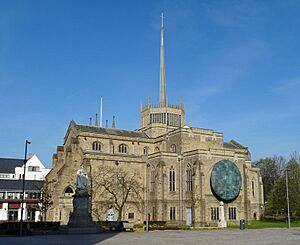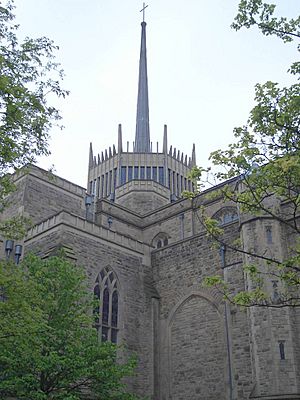Blackburn Cathedral facts for kids
Quick facts for kids Blackburn Cathedral |
|
|---|---|
| Cathedral Church of St Mary the Virgin with St Paul |
|

The Cathedral from the west
|
|
| 53°44′50″N 2°28′53″W / 53.7473°N 2.4813°W | |
| Location | Blackburn, Lancashire |
| Country | England |
| Denomination | Church of England |
| History | |
| Consecrated | 1977 |
| Architecture | |
| Architect(s) |
|
| Style | Gothic Revival |
| Years built | 1820–1967 |
| Administration | |
| Diocese | Blackburn (since 1926) |
| Province | York |
Blackburn Cathedral, officially known as the Cathedral Church of Saint Mary the Virgin with Saint Paul, is an Anglican (Church of England) cathedral. It is located in the centre of Blackburn town, in Lancashire, England. A church has stood on this spot for over a thousand years. The first stone church was built here during Norman times.
Contents
History of Blackburn Cathedral
Becoming a Cathedral
In 1926, the Diocese of Blackburn was created. This new church area was formed from the Diocese of Manchester. Because of this, the important parish church of St Mary the Virgin became a cathedra. A cathedral is the main church of a diocese.
The church building was first built in 1826. It was designed by an architect named John Palmer. This part of the church is now the cathedral's nave, which is the main part of the church where people sit. It replaced an older parish church that was taken down between 1819 and 1820.
Expanding the Cathedral
In the early 1930s, people started raising money to make the cathedral bigger. They wanted the building to look as important as its new status. By 1938, enough money was collected, and work began to expand the cathedral.
The work was stopped during the war. However, it started again afterwards and continued through the 1950s and early 1960s. The original architect, W.A. Forsyth, passed away in 1950. Another architect, Laurence King, then joined the project. He designed the special lantern tower. This tower has 56 different coloured glass panes. It also has a modern, thin aluminium spire. The lantern tower was finished in 1967.
The entire cathedral was finally completed in 1977. All the parts that had been built over many decades were officially made part of Blackburn Cathedral that year.
Special Features and Events
The north part of the cathedral, called the transept, has eight misericords. These are special wooden seats with carvings on the underside. They date back to the 1400s. No one knows exactly when they arrived at the cathedral. However, it is thought they came from Whalley Abbey. This abbey was closed down during the Dissolution. It is possible the misericords were stored away for about 300 years before being used in the new cathedral.
On April 17, 2014, Blackburn Cathedral hosted the Royal Maundy service. This is a special event where the monarch gives out symbolic money. Following tradition, Elizabeth II gave Maundy money to 88 men and 88 women. This was Queen Elizabeth II's first visit to the cathedral.
In 2023, a special agreement was made between the cathedral and a local Welsh Presbyterian church. They decided to share the lady chapel within the cathedral. This was a very unique agreement. It is believed to be the first time a cathedral has made such a sharing plan with a church that is not part of the Church of England.
Cathedral Leaders
As of November 30, 2020, the main leaders at the cathedral include:
- The Dean is Peter Howell-Jones. He started this role on March 25, 2017.
- The Canon Missioner is James Lawrence.
- The Canon Precentor is Jennifer Gaffin.
Music at the Cathedral
The person in charge of music and the organist is John Robinson. John Hosking is the organist in residence.
Cathedral Choirs
Blackburn Cathedral has several choirs:
- The Cathedral Choir of Boys, Girls, and Men.
- The Youth Choir, which used to be called the Young Peoples' Choir.
- The Blackburn Chamber Choir, previously known as the Renaissance Singers or the Bach Choir.
- St Paul’s Singers.
On Sundays, the Youth Choir sings for the Parish Communion service. The Cathedral Choir sings for the Eucharist and Evensong services.
The Cathedral Organ
The first organ for the new church was designed by John Gray and Frederick Davison. It was first played on February 28, 1828. A concert of music by Handel was performed. This included parts from his famous works like Messiah and Israel in Egypt. The new organist, Joseph John Harris, played the music. This organ was later replaced in the 1870s by an instrument designed by Aristide Cavaillé-Coll.
The third and current organ at Blackburn Cathedral was built by J. W. Walker & Sons Ltd. It was finished in 1970. A generous person named William Thompson, from Burnley, helped pay for it. The organ was repaired and updated at the end of the 1900s by Woods. It is considered a very high-quality instrument. It is used for recordings, concerts, and special organ performances throughout the year.
Organists of the Cathedral
List of musicians at English cathedrals Since 2019, John Robinson has been the organist and director of music. Many talented organists have worked at the cathedral before him. These include Henry Smart, Richard Henry Coleman, and Gordon Stewart. John Hosking has been the organist in residence since 2022.
Cathedral Bells
The first mention of bells at the old parish church was in 1552. The church leaders bought five bells for £26-12-1. In 1737, a new set of six bells was made from the metal of the old ones. This set of six bells was moved to the west tower of the new church in 1832. Four more bells were added between 1851 and 1852, making a total of ten bells.
In 1949, while the cathedral was being expanded, the current set of ten bells was put in place. All ten bells were made by John Taylor & Co. in Loughborough. The largest bell, called the tenor bell, weighs about 1,289 kilograms. It is tuned to the note D and is 1.32 metres wide.
Recent Changes and Art
Building Improvements
In 1998, the lantern tower was repaired. It was rebuilt using natural stone. The original tower from the 1960s was made of concrete. The windows were also replaced during this work.
More work was done in 2000 and 2001. The roofs and walls at the east end of the cathedral were rebuilt. They were made to blend in with the older parts of the building. After this work was finished, the cathedral was finally considered complete. This was after more than 70 years of construction!
New Art and Community Role
Along with the rebuilding, a new piece of art was created for the outside of the cathedral. This sculpture is by Mark Jalland. It is called The Healing of The Nations. It is a large, circular piece made of steel and copper. It has thousands of tiny fibre optics woven into it. These create changing patterns of light at night. Many people think it is one of the most creative modern sculptures at any English cathedral.
In 2009, the flagpole was replaced. It was carved by Mark Bridges. At the very top, it has a bishop's mitre finial. This is painted and covered in gold leaf with the Lancashire Rose symbol. Most of the money for this came from a gift left by Harold Thornber. He had worked at the cathedral as a warden and archivist.
Blackburn Cathedral is still a very important part of the community. It welcomes visitors and has a café. It also hosts many events. For example, in February 2011, the cathedral showed the Quaker Tapestry from Kendal.
In 2021, the crypt (an underground room) of Blackburn Cathedral was used as a large public vaccination centre. This helped people get vaccinated against COVID-19.
Gallery
See also
- Listed buildings in Blackburn














